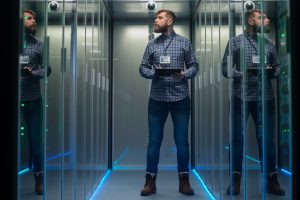Power, or more correctly, a reliable power supply, is a critical resource for any data center. But for co-location service providers working to strict SLAs, the power system design to support the critical load is often complex and significantly different to that of other enterprise data centers. Hiren Lad, software architect at Schneider Electric explains why co-lo data center operators would want to know about the power architecture and its dependencies.
“A co-lo environment is very unique,” he says. “It’s a very large environment spaced out for lots of customers. To keep that system running they have to have a very detailed electrical system. To understand that electrical system in most tools is quite hard, so therefore within StruxureWare Data Center Operations for Co-lo you need to able to put the actual electric system into the actual product. You need to be able to model it, map it and be able to tell them where their capacities are, where the power usage is and where that power is being delivered from and to.”
In demonstrating the software, Hiren says, “The way that this works is, that once we have depicted the actual area that we want to see, we’ve lifted the assets and placed them into the system, we need to be able to see the electrical structure. A data centre of this size would have some vast electrical system, so if we zoom into the electrical system of that site, you can see that I’ve actually got a very complicated electrical system shown on the page but actually done it in an easier context than what you would normally see in a large scale BMS or in some kind of mechanical, electrical modification system.
“In here what we are actually depicting is three UPS’s, coming out in six different distribution panels by crossing the power over. If I was to zoom in and take this UPS you can see this one is a red feed, this one is a green feed and this one is a blue feed. When we get down to this point, what we are showing is that this one is actually a mixed UPS and this one is coming out through this power here. It doesn’t look very detailed but for a co-lo this is important to be able to see where the feeds are, the redundancy, the resiliency, to be able to make sure that if they are doing any work there is power there for the customer not to go down. Essentially they are there to ensure that a customer stays up 100% of the time”.
Having a clear understanding of the power architecture has an effect on SLA’s, KPI’s and essentially the way that the co-lo operates. Power infrastructure is critical to the successful operation of customer’s IT equipment, as well as the supporting cooling and other plant. Since there are many and various UPS configurations that can be implemented, each with its own advantages and limitations, an understanding of the facility’s capability to deliver the availability requirements, risk tolerance, and budget capability, can only be arrived at if the power system architecture is well understood.
More details regarding StruxureWare Data Center Operation for Co-location can be found on the Schneider Electric website, together with white papers and other resources.



